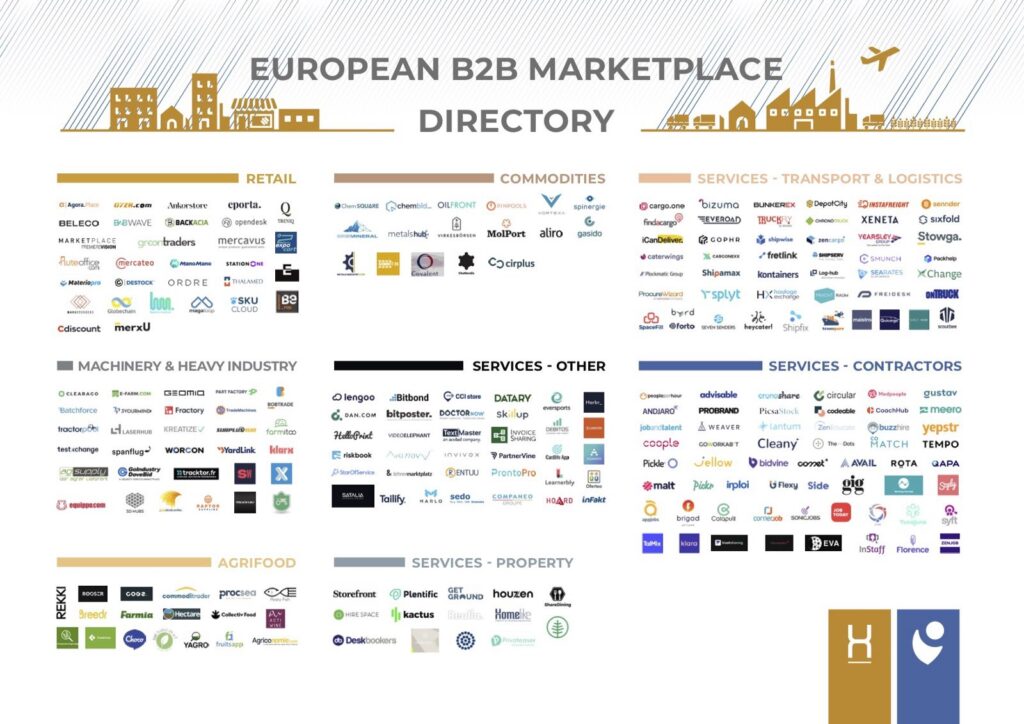
Marketplaces and the Omnichannel Future of Live Events
Online marketplace platforms are an essential part of the evolution of the exhibition model. Here’s a complete guide on how to get started.
Download the full ebook, The Marketplace Blueprint
If 2020-21 has taught us anything, it’s that having all your business rooted in one particular channel comes with a high degree of risk.
The pandemic exposed the huge lack in resilience of an ‘Events first’ strategy, highlighting that supporting the community is what comes first, rather than any particular channel or time-based event, hybrid or otherwise.
While the move organisers have made from physical to virtual has brought with it some benefits, notably the amount of data about customer behaviour, it isn’t the full transformation required.
Virtual platforms have demonstrated strong performance for content and webinar experiences. Visitor engagement has been higher in many cases than the live event counterpart and successful in attracting new and international audiences who wouldn’t have been able to attend previously.
But when it comes to providing a platform for buying and selling – the critical need of exhibition businesses – they have fallen short. The industry benchmark for exhibitor Net Promoter Scores (NPS) for virtual events platforms seems to be averaging less than -40. It’s clear that including exhibitor profiles as part of a virtual event package is not the full answer to the more fundamental changes needed to drive exhibitor value through digital channels.
The retail industry evolved quickly from a reliance on the in-store channel to an omnichannel model, where the buyer has control of how and when they want to buy, whether shopping online from a mobile device, a laptop or in a brick-and-mortar store. This shows the real transformation that is required to for an exhibition brand to become a true hybrid of digital and physical.
Furthermore, organisers must recognise there has been a generational shift where this approach will be more expected and attracted.
In order to create this kind of omnichannel experience, an essential component is to have a year-round marketplace that can directly connect buyers and sellers throughout the year, which can work seamlessly to support and enhance the event experience. Here are some pointers for how event organisers can think about implementing a marketplace as part of their engagement with their community.
Here are some pointers for how event organisers can think about implementing a marketplace as part of their engagement with their community.
What is a marketplace?
A marketplace business is one that:
1. connects demand (i.e. people who want a thing)
2. with supply (i.e. people who have that thing)
3. to lead to a financial transaction.
Marketplaces generally own any supply, do not provide products or services directly, and either deliver leads or handle the money being exchanged. Its role is to provide a trusted environment where the supply and demand efficiently find each other and transact successfully.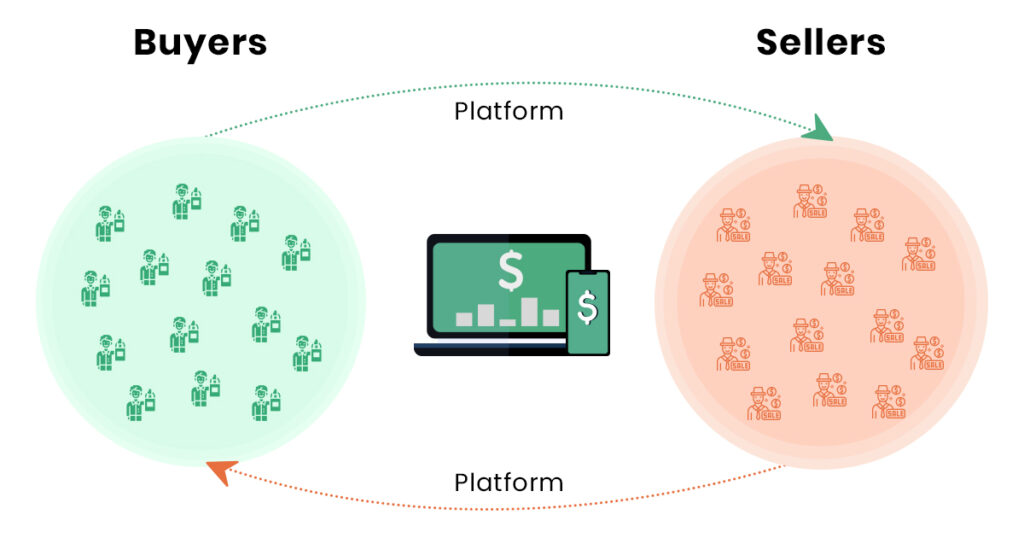 Specialist B2B marketplaces are moving fast into the industries exhibitions traditionally serve. Even before the pandemic:
Specialist B2B marketplaces are moving fast into the industries exhibitions traditionally serve. Even before the pandemic:
- $1.86 Trillion spent globally on the top 100 online marketplaces in 2018 and account for more than half of global online retail sales. Source: Digital Commerce 360’s 2020 Top 100 Online Marketplaces Database
- 80% of B2B buyers now expect a convenient purchasing experience similar to those offered by B2C websites such as Amazon, Alibaba, Uber, AirBnb etc.
- 87% of B2B Buyers (and 97% of Millennials) said they buy through marketplaces more than any other channels. Source: Mirakl / Gartner
- 300 B2B marketplace startups with more than €3 billion funding in Europe according to Point Nine
Why are marketplaces great businesses for event organisers?
Marketplaces are the perfect example of the networked business which have risen to dominate the web. There are a number of reasons why marketplaces are an attractive line of business:
- Network effects: the more users you get, the more useful/cheap your product becomes, the more users you get (e.g. Lyft/Uber vs. taxis)
- Barrier to entry: Once they have a strong network effect, it becomes increasingly difficult to enter or replicate the marketplace (e.g. Airbnb vs. hotels). Ecoystems of users are the new source of competitive advantage and market dominance.
- No inventory means they are can be cheaper to operate (e.g. Airbnb vs. hotels), easier to scale (e.g. Rover vs. dog hotels) and easier to pivot (e.g. Uber Black -> Uber).
For event organisers, online marketplaces come with some specific advantages:
- Audience growth. Your brand(s) can become embedded into the workflows of buyers year-round by providing an essential tool for finding and comparing products and services, which can significantly grow your audiences.
- Revenue growth. Bundling recurring revenue subscriptions to a marketplace alongside exhibiting at an event is an opportunity to increase the value of exhibiting, gives suppliers more leads and ROI.
- Brand protection. Most importantly, having a marketplace in your portfolio presents the opportunity for forward-thinking organisers to embed themselves in the transactions between our visitors and exhibitor audiences outside the confines of an exhibition.
Marketplaces should be viewed as an essential part of the new omnichannel event model, creating seamless customer experiences across live and digital channels: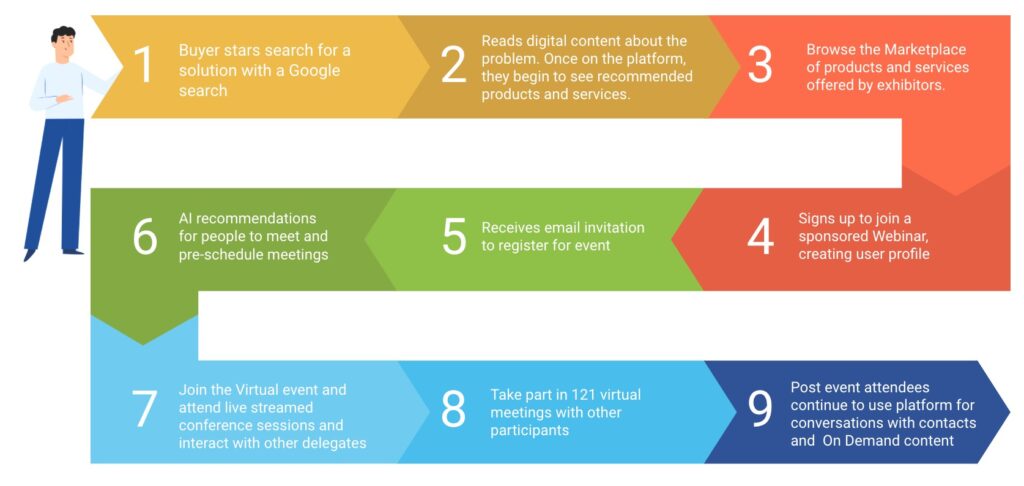 Do marketplaces compete with live events?
Do marketplaces compete with live events?
An objection I have often met with colleagues over the years has been “but won’t this compete with and replace the physical event?”
Pre-pandemic my answer used to be twofold:
Firstly,
“Disruption is already here. In your market, there are already likely several startups doing this and I’d rather we were the ones doing the disrupting.” – a statement which is more true today than ever.
Then I’d quickly follow ” But we’re underestimating the power of face-to-face events if we think an online marketplace can ever replace them”.
I’m less convinced today by this argument. Customers will have had 2 years of finding a purely digital way of doing business, rapidly accelerated the existing trend towards digital procurement in both B2B and B2C. For buyers and sellers that have found it to be a cheaper and more efficient way of working, this is unlikely to reverse when events reopen.
In my view, live events will always play a massively important role in bringing markets together to learn and connect with each other. But it is naive to think that buyers will always wait for an event if they have an important buying decision. To avoid becoming dis-intermediated by more agile, digital-savvy competitors we need to ensure that any buyers with intent come through one or more of our channels.
How to create an online marketplace alongside event businesses
If you want to establish an online marketplace alongside your events, here are a number of points events organisers need to tackle:
Start with a focus on 1-2 specific markets
Marketplaces take time and focus to become established and need to solve a specific industry need, so concentrate on one or two industry verticals, rather than scaling the same technology solution across multiple markets too quickly.
When considering which markets to focus on, the good news is that conditions for successful online marketplaces are very similar to those for successful exhibitions, starting with having a large total addressable market, a fragmented market of suppliers, and by identifying an opportunity for technology to unlock new value.
Bill Gurley’s 10 factors for evaluating a marketplace opportunity is a helpful framework for how this successful investor in marketplaces such as eBay, OpenTable and Uber evaluates opportunities.
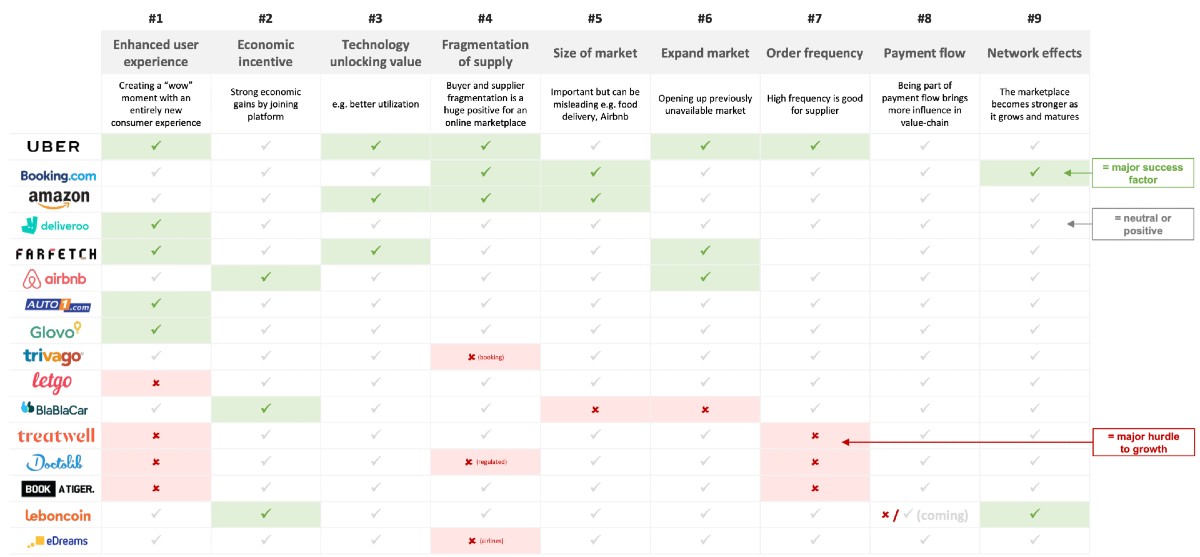 There is usually very different competition level between marketplaces for finished products- which are usually already well served by e-commerce stores – and supplier solutions relationships that require more consultation or raw ingredients. The latter area is more complicated and so tends to be less crowded space to break into.
There is usually very different competition level between marketplaces for finished products- which are usually already well served by e-commerce stores – and supplier solutions relationships that require more consultation or raw ingredients. The latter area is more complicated and so tends to be less crowded space to break into.When considering the overall size of the opportunity, it’s a mistake to allow internal silos between event brands, geographies and databases to get in the way. The objective is to provide your customers with the maximum number of products and companies in any given vertical as quickly as possible.
This can be easier to solve if you already have one recognisable international brand trusted by your industry which can be used successfully online. If your event portfolio trades under many brands in different names in different geographies, consider using a new name to unify them online with a standardised taxonomy.
Determining the Product/Market Fit (PMF)
Product-Market Fit is achieved when a product meets real customer needs and does so in a way that is better than the alternatives.
To be successful B2B marketplaces need to adapt their approach to solve a variety of industry-specific problems to be adopted by your customers. They may include:
- Slow purchasing cycles and decision-making
- Too many stakeholders
- Highly complicated payments
- Structural mismatch between commission-based vendor sales teams and current online buyer preferences
- Gated pricing information at the expense of product visibility
- Friction along the buyer’s journey: complex ordering, reordering, and fulfilment requirements
- A lack of automation, personalisation, and overall customer experience
Having defined the target customers on both sides of the marketplace, the next step in creating a successful marketplace is to understand what customers want and will pay for.
Some questions to help determine and validate the customer pain points include:
- What core problem(s) is the marketplace trying to solve?
- Who has the problem and how is this person dealing with the problem now? How often do you search for new products/services?
- How do you compare vendors to decide which products/services would be the best for you? Is it easy to book and pay for products/services?
- How do suppliers currently attract customers? How do you currently manage customers’ bookings and how do they invoice?
To understand an industry’s buyer-seller dynamics it can be useful to ask both buyers and sellers to rank the features that would be most useful to them.
Value Proposition
It is important to establish clear value proposition for both buyer and seller personas. Marketplaces are designed with core value exchange at the heart, the “white-hot centre” of the flywheel, which creates buyer and seller liquidity
As the platform grows, new kinds of interactions may be built on top of the core interaction, e.g. LinkedIn went from CV -> Job listings -> Thought leadership content
To successfully attract buyers, marketplaces must have some combination of the following factors:
1. Trust and Quality Pre-vetted or rated suppliers
2. Efficiency. Faster than using traditional methods
3. Price. The cost of using the platform is significantly cheaper than the alternativeTo attract sellers, the main value proposition is acquiring new customers and lots of them.

Marketplace Monetisation models
A key distinction to make on the overall scope of the marketplace is whether it will process payment.
The two main options to consider are whether it should:
(1) mirror the model of most events by making the initial business connection in a lead-generating marketplace, usually based on a supplier listing fee or subscription
(2) deliver the entire order with e-commerce in a transactional marketplace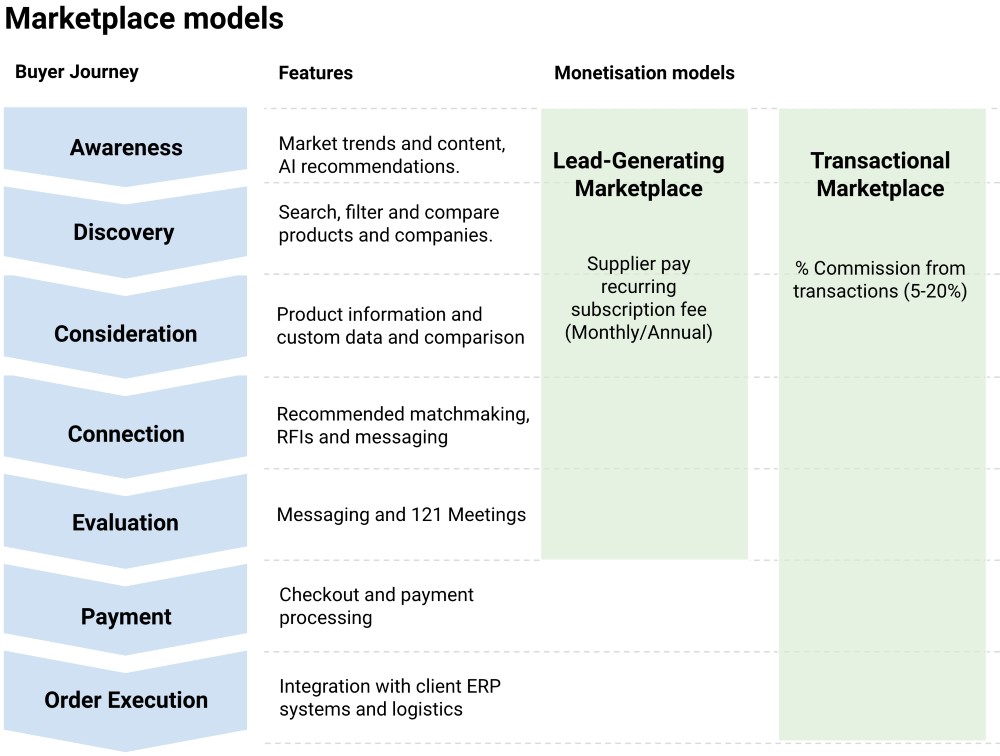 Transactional marketplaces are widely used in B2C and have a major advantage as the cost to participate is buried in a percentage of the order, so is a model which has less friction to participate and can prove to be a scalable revenue model. However the order complexity in many B2B markets means a lead generating approach may often be a better solution for trade show organisers.
Transactional marketplaces are widely used in B2C and have a major advantage as the cost to participate is buried in a percentage of the order, so is a model which has less friction to participate and can prove to be a scalable revenue model. However the order complexity in many B2B markets means a lead generating approach may often be a better solution for trade show organisers.Here are the options to consider:
- Supplier subscription/listing fee. The most common model for directories which, like Classified ad platforms, charge a fee for new listings. Listing fees can be a form of quality control so your marketplace is less likely to be flooded with low-quality products and poorly written listings.This model has been most effective when combined with exhibition sales but if tied too closely to the fortune of the event has downsides in that a) it may not scale beyond the event’s health and b) can be viewed as a tax.
- Transaction fees. The commission model scales the best by building on the network effect. The best-known marketplaces, including Airbnb, eBay, Uber, and Etsy, all charge a commission from each transaction that takes place on their platform, either in the form of a percentage or a flat fee. This model is especially appealing for the suppliers or providers, as they only have to pay the marketplace operators if they sell something. It therefore encourages more suppliers to list their products or services and improves supply liquidity. Commission can range from 5-15%. However, this is not easily implemented in B2B industries have long lead times and complicated invoicing processes that the marketplace cannot facilitate easily with e-commerce.
- Buyer membership fees. If you’re confident that your marketplace will provide great value and warrant repeat transactions, you can charge a membership or subscription fee. However, this needs to be used carefully as mandatory fees can be a major barrier to users from signing up, potentially killing volume the leads your suppliers will receive.
- Freemium. The marketplace can be free for suppliers and/or buyers to get started with, but premium features come at an additional cost. Even with games, only around 2% of the total users ever pay for the premium offerings, but they may spend enough to make the venture profitable. The value-added services your marketplace offers need to provide enough value and be interesting enough for a wide audience, and coming up with the right mix can be difficult.
Constrain the scope of the marketplace
While this can go against the instincts of organisers of large exhibitions covering multiple product areas, it is important to begin with a specific, focused niche.
Amazon started with books, AirBnb with airbeds. The majority of successful marketplaces start with constraints to more quickly get to critical mass and achieve liquidity of supply and demand.
“The best marketplaces end up supply-constrained because they tap into an incredible amount of demand. The product/market fit is so strong that this demand puts pressure on supply.” Li Jin (partner at a16z)
A marketplace can be constraining by geography (launching in particular city or postcode) or by category (focusing on a particular niche) – likely both. If the service requires supply and demand to meet, e.g. Taxis, Food Delivery, it always started with a geographical constraint.
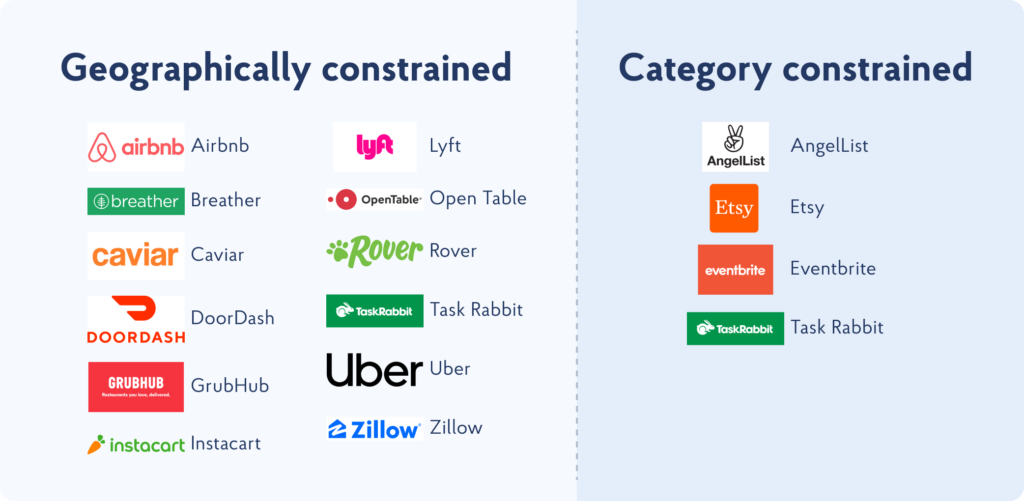 Source: Lenny Rachisky
Source: Lenny RachiskyFurthermore, AI matchmaking helps provide curated options to filter through the noise and connect to content and products that are actually useful.
Supplier quality management
 A two-side marketplace is often called a ‘chicken and egg’ problem, as they only work when both buyers and sellers are present.
A two-side marketplace is often called a ‘chicken and egg’ problem, as they only work when both buyers and sellers are present.However, 90% of successful marketplaces concentrated on building supply first, before introducing to buyers. Our primary role is to create a trusted environment which can become an essential tool for buy-side.
“When I started looking at the evolution of how marketplaces like ours grow, the playbook is the same: Get restaurants -> Get delivery people -> Get customers. The largest growth lever has always been the supply — the restaurants. They bring the demand.” Micah Moreau, Door Dash
In the majority of markets, it’s clear that products and services themselves are of far greater interest than the companies supplying them. The vast majority of searches on marketplace platforms are for products or product categories, rather than a company. This means it’s critical that organisers find a way of getting comprehensive product information and data from their suppliers into a structured format.
Unlike exhibitor listings and directories of the past, this requires investment in building out a comprehensive, data-rich supplier and product profiles.
This will typically involve:
a. Customer success agents to onboard and support suppliers, year-round.
b. Supplier dashboards to make it easy for them to publish products and get feedback
c. Marketing automation as part of onboarding and nurturing process. Triggered email campaigns are far more effective than ‘batch sends’, none more so than in onboarding customers. In a recent benchmark report by Blueshift, triggered onboarding emails are +826% more effective.
To improve the quality of product and company listings further, here are some common techniques:
- 3rd party data sources can be used to augment the listings with helpful data points.
- Review system: Having a review system was fundamental for maintaining a level of quality (and trust).
- Onboarding Assets: ‘How To’ Guides are a common tool in onboarding suppliers and used as a reference tool.
- Standards and penalties. To maintain quality in their marketplace, the most important factor is to define (and share) clear standards for the minimum level of service.
“We published community guidelines that outlined what kind of events were permissible on the platform and invested in a fraud/spam team to build technology to catch bad actors. We saw ourselves as the fair arbiter between guests and sellers.” Tamara Mendelsohn, Eventbrite
Grow buyer acquisition and retention
To optimise for buyers, a focus on audience acquisition through SEO is of the most importance. Organic search can be 70%+ of traffic, the site’s taxonomy, product profiles and content strategy designed around attract maximum funnel of users with intent to buy. The commercial strategy needs to be aligned building your search traffic. For example, make sure you don’t simply remove companies who are no longer paying, as this creates dead links which are damaging to your SEO, but instead move them down to a reduced basic listing.
Marketplaces generally spend too much time acquiring new users instead of focusing on retaining existing ones Attracting new customers costs 5 times as much as keeping an existing customer.
Consumer marketplaces such as Etsy attribute 78% of their sales to repeat purchases, and in B2B our buyers can be significantly more valuable.
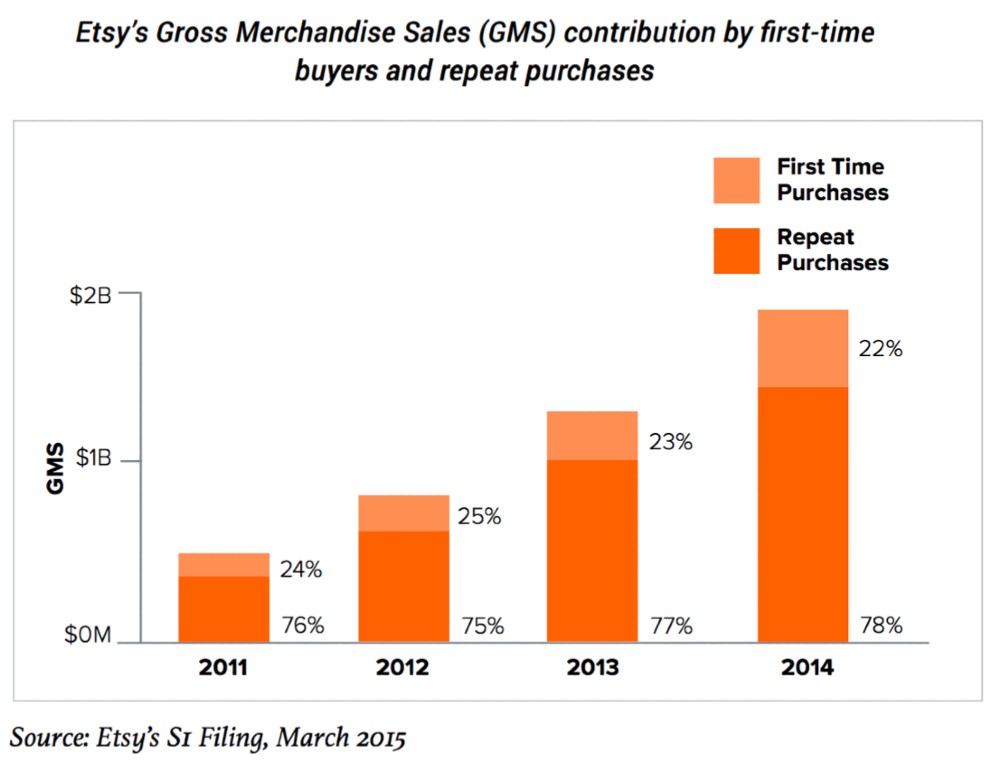 One of the most reliable ways to keep existing users engaged with your product is through emails, which become significantly more effective the more personalised you can make them based on their behaviour.
One of the most reliable ways to keep existing users engaged with your product is through emails, which become significantly more effective the more personalised you can make them based on their behaviour.Provide self-service tools and transparent ROI
Modern marketers are used to getting real-time feedback to their PPC spend on Google or LinkedIn, and it is important that marketplaces can offer a similar self-service experience.
The more user-friendly the platform, the more users can see the return they are getting, the more products and news they will upload and the more time they will invest with us.
The omnichannel model means that we need to be able to show suppliers measurable ROI from all their engagement with us – digital or event- with dashboards of leads which they find of business value in one place. If we can prove the return, and make it easy to self manage, then this will help ensure that customers keep in on their digital marketing plans alongside other forms of measurable marketing.

Google AdWords Dashboard
Focus on the KPIs that matter
“Liquidity isn’t the most important thing. It’s the only thing.” Simon Rothman, Greylock Partners (Ebay, Lyft, Tango etc)
Marketplaces are a data-driven business, and the most important metric is that of liquidity. Liquidity means the efficiency with which a marketplace matches buyers and sellers on its platform and any features, upsells or content which blocks or distract from that core purpose should be removed.
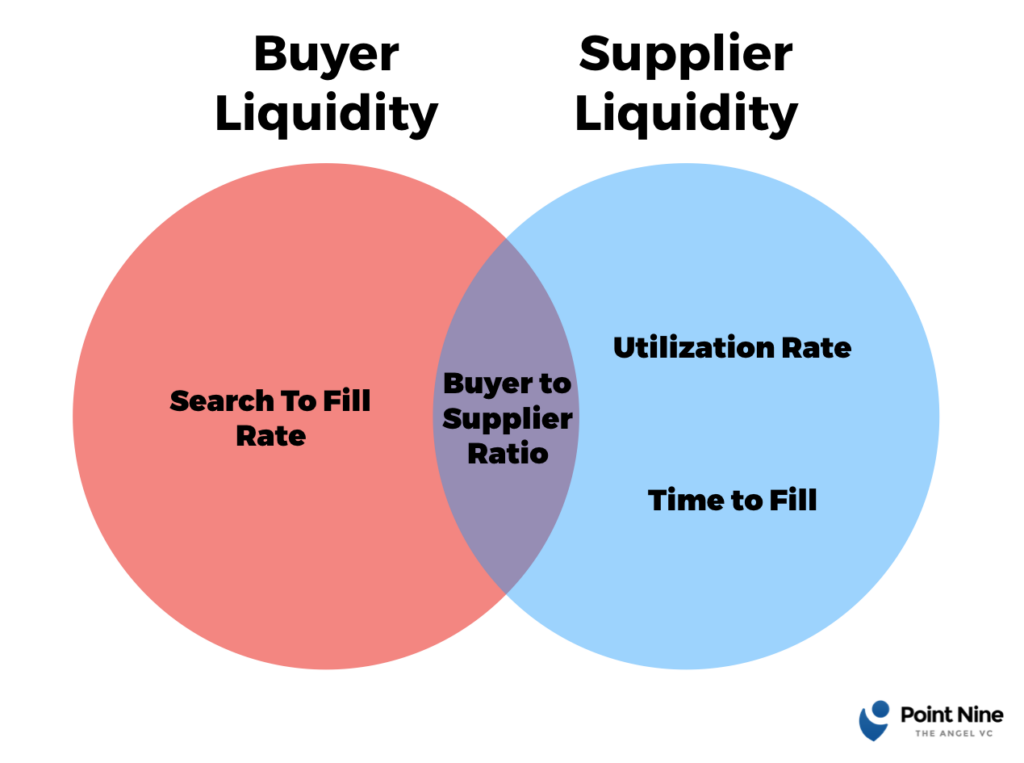 KPIs should be established, measured and reviewed weekly to ensure that all team efforts are aligned to improving performance against this goal. Here are some useful KPIs to build into your dashboard when growing a marketplace business:
KPIs should be established, measured and reviewed weekly to ensure that all team efforts are aligned to improving performance against this goal. Here are some useful KPIs to build into your dashboard when growing a marketplace business: Team responsibilities should be assigned across the customer journey to improve these metrics, to continuously testing to improve the proposition and platform with ongoing customer validation and A/B testing
Team responsibilities should be assigned across the customer journey to improve these metrics, to continuously testing to improve the proposition and platform with ongoing customer validation and A/B testingChoosing a marketplace platform
Marketplaces include a number of specific features which are used by the operator, buyers and sellers.
Here are some of the features which may be important in building your marketplace:
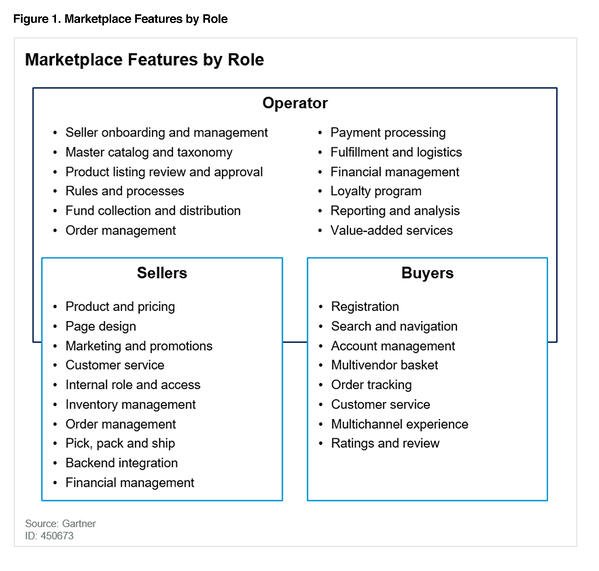 For exhibition organisers trying to create a seamless experience between the event and marketplace, there are some specific needs which need to be met, including:
For exhibition organisers trying to create a seamless experience between the event and marketplace, there are some specific needs which need to be met, including:- Is the platform search engine optimised?
The number one lever to grow an online marketplace is search engines. Search is the best way of finding fresh buyers with intent and should account for at least 70% of your traffic. This is in direct contrast to how virtual event platforms typically hide their exhibitors and content within a logged-in environment that can’t be discovered through search.
- Is the platform search engine optimised?
- Can the platform offer one seamless experience between event and marketplace?
In 2021 the type of experience we should be aiming to deliver to our community allow for a seamless transition from community to event and back again. This works better both for customers, who don’t have to jump between platforms and for organisers who can progressively build richer profiles of the audience and offer increasingly personalised products and recommendations. It is far easier to achieve a seamless experience one on the platform rather than stitching together several. Consider how the customer journeys of the event and the marketplace complement each other.- The user profile should be consistent from community, to marketplace, to the event.
- Marketplace users should access profiles without friction, and be presented with calls to action to draw them into participating in the invent.
- Once an attendee is within an event, you don’t want to lose them from within the event environment when browsing exhibitors.
- Suppliers expect a joined-up journey with a consistent dashboard so that they don’t have to upload content in more than one place.
- At what point do we have to ask attendees to register to an event, if at all.
- Can the platform offer one seamless experience between event and marketplace?
- Can the marketplace be customised for your industry?
There are specific needs that every industry needs has, and in the case of marketplaces, the procurement journey can be quite different from one market to another. For example, for some industries, the greatest need is to search by certification or other customer data fields, while in others it might be comparing of delivery times, in others it might be for a tendering process to send one quote to multiple suppliers and collate their feedback.Will it allow your team to run A/B tests and try different designs? It’s important to ensure that your partner is flexible enough to be able to customise the platform to meet your specific use case, and to grow with you over time.
- Can the marketplace be customised for your industry?
- Keep your data
Data is the lifeblood of your community, so make sure that the contract ensures you keep your data remains your own – many don’t – and that it can be pulled back into your database.
- Keep your data
To have a conversation about how marketplaces can form part of your brand proposition, please drop me an email.
There's more you might like
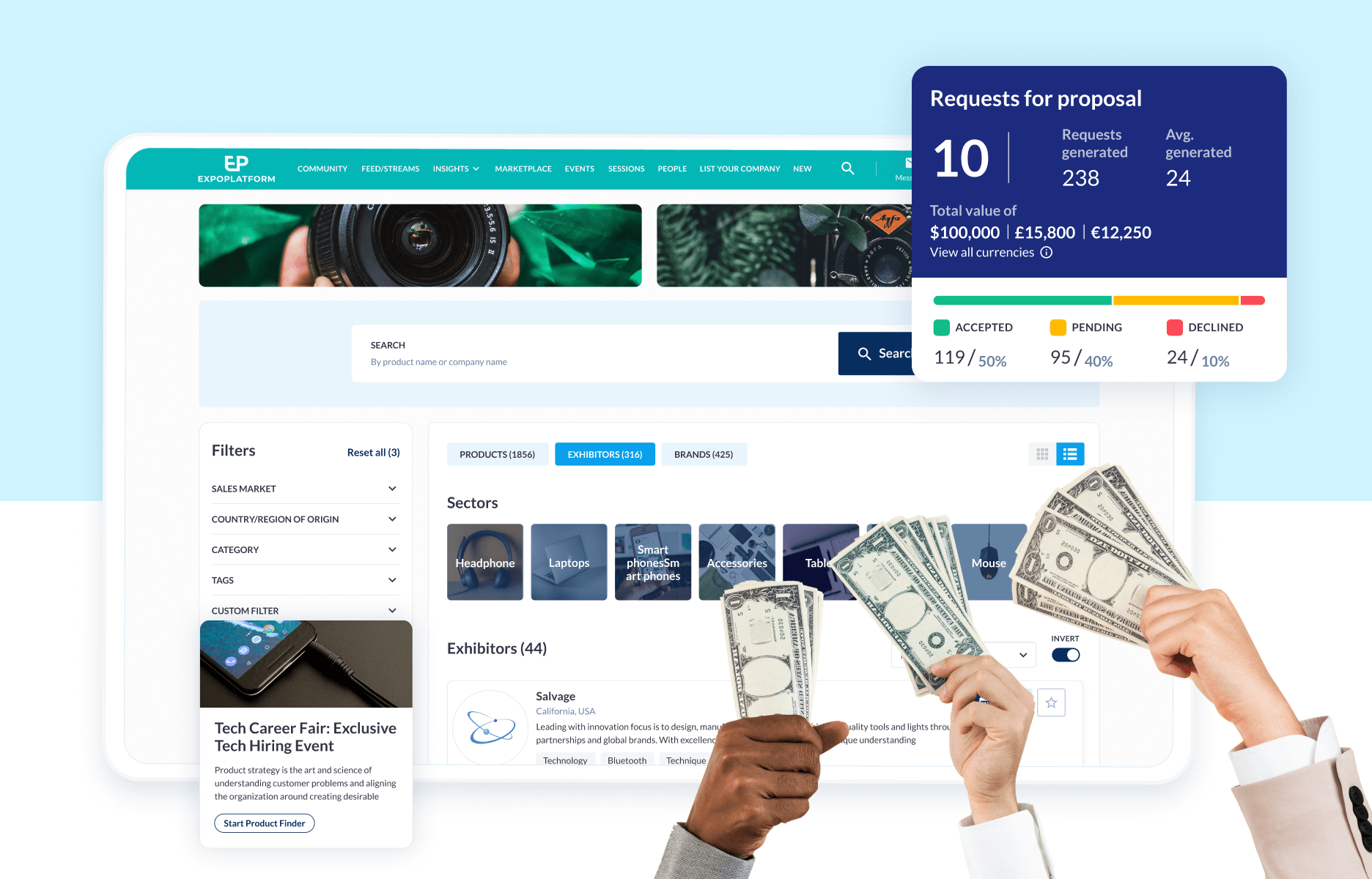
How to make your events more profitable with 365 marketplaces
Online marketplaces are fast becoming the go-to models for tradeshow organizers to get more buy-ins for their businesses and drive revenue year-round. According to Research and Markets, the global B2B e-commerce platform market value stood at $8,916.6 million in 2022 and is expected to grow to around $10,059mn this year. It is further projected to ...

10 ways online marketplaces are a bonus for eventprofs
The rise of online marketplaces has been a boon for B2B events – allowing organisers to widen their connections beyond the limits of in-person shows. Always online ecommerce sites help buyers explore new products around the year, compare prices and get the best deals for their purchase. Exhibitors can use these platforms as a convenient ...
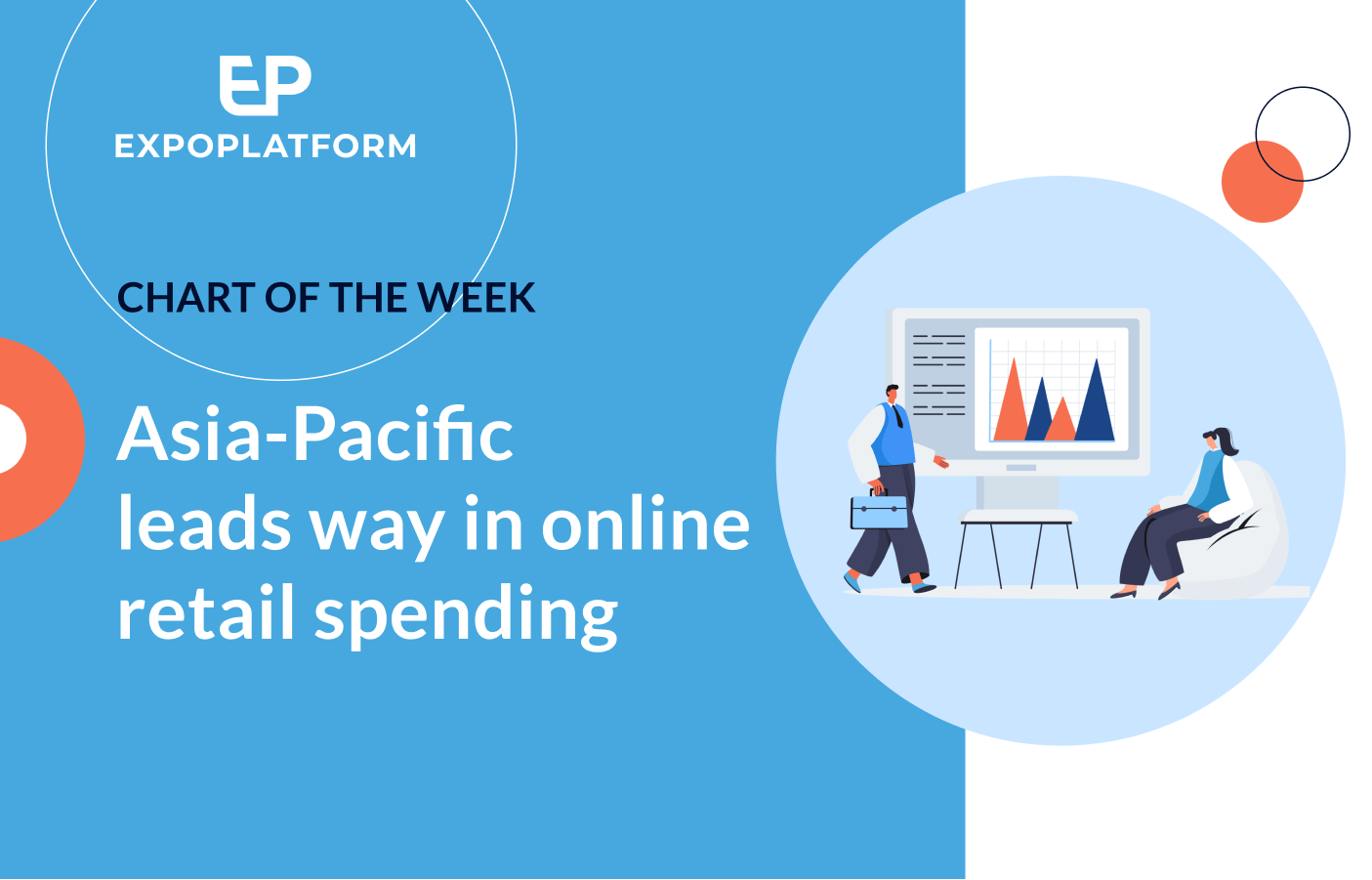
Asia-Pacific leads way in online retail spending
Asia-Pacific has emerged as the leading market for online retail spending, new research shows. The Wunderman Thompson Commerce’s Future Shopper Report 2022 said shows 57% of global spending is now done through digital channels. However, the study found the most significant shift has been witnessed in the Asia-Pacific region. Figures show online spending in China ...


